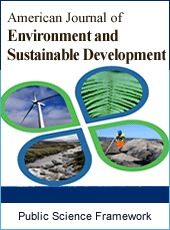American Journal of Environment and Sustainable Development
Articles Information
American Journal of Environment and Sustainable Development, Vol.6, No.4, Dec. 2021, Pub. Date: Dec. 6, 2021
Study of the Efficiency UASB Reactors in the Treatment of Wastewater at 35°C
Pages: 128-132 Views: 5237 Downloads: 934
[01]
Masood Abdusalam Ghanem Ali, Department of Geology and Environment, Faculty of Sciences, Baniwaleed University, Baniwaleed City, Libya.
[02]
Amer Gheit, Department of Geology and Environment, Faculty of Sciences, Baniwaleed University, Baniwaleed City, Libya.
[03]
Salim Shouran, Department of Geology and Environment, Faculty of Sciences, Baniwaleed University, Baniwaleed City, Libya.
The research assessed the potential of up flow anaerobic sludge blanket (UASB) reactors to provide full-flow anaerobic treatment of wastewater 35°C. The work was carried out using laboratory-scale UASB reactors fed on a wastewater. The reactors were operated under a range of condition to test their performance and stability based on four main indicators: chemical oxygen demand (COD) removal, total suspended solids (TSS) removal, gas production and gas composition. The results from this investigation showed that UASB reactors operated at a temperature of 35°C were highly effective in the treatment of synthetic sewage at influent COD concentrations from 450 to 2250 mg l-1 COD at a constant HRT of 1 day, and at HRT from 24 to 8 hours with an influent COD concentration of 450 mg l-1. The specific methane yield obtained was around 0.32 l CH4 g-1 COD removed. COD removal efficiencies were high at ≥ 93% and total suspended solid removal was around 95%. The results confirmed that full flow treatment under mesophilic conditions, was feasible at wastewater temperatures of 35°C. The warm temperate areas that are suited to this application, e.g. Libya also often have relatively low water use and/or high rates of re-use due to water scarcity.
(UASB) Reactors, COD Removal, TSS Removal, Methane, Mesophilic Conditions
[01]
Alvarez, J., et al. (2006). "Start-up alternatives and performance of an UASB pilot plant treating diluted municipal wastewater at low temperature." Bioresour Technol 97 (14): 1640-1649.
[02]
Chernicharo, C. A. d. L. (2007). Anaerobic Reactors: Biological Wastewater Treatment Volume 4 (Biological Wastewater Treatment Series). London; New York, IWA Publishing.
[03]
Collins, G., Foy, C., McHugh, S., & O’Flaherty, V. (2005). Anaerobic treatment of 2, 4, 6-trichlorophenol in an expanded granular sludge bed-anaerobic filter (EGSB-AF) bioreactor at 15° C. FEMS Microbiology Ecology, 53 (1), 167-178.
[04]
Collins, G., Woods, A., McHugh, S., Carton, M. W., & O'Flaherty, V. (2003). Microbial community structure and methanogenic activity during start-up of psychrophilic anaerobic digesters treating synthetic industrial wastewaters. FEMS Microbiology Ecology, 46 (2), 159-170.
[05]
Cronin, C. and K. Lo (1998). "Anaerobic treatment of brewery wastewater using UASB reactors seeded with activated sludge." BIORESOURC TECHNOL 64 (1): 33-38.
[06]
Gonçalves, R., Charlier, A., & Sammut, F. (1994). Primary fermentation of soluble and particulate organic matter for wastewater treatment. Water Science and Technology, 30 (6), 53-62.
[07]
Idrus, S. (2013). Washing of wheat straw to improve its combustion properties with energy recovery by anaerobic digestion of the washwater. UNIVERSITY OF SOUTHAMPTON Faculty of Engineering and the Environment.
[08]
Lettinga, G., & Pol, L. H. (1991). UASB-Process Design for Various Types of Wastewaters. Water Science & Technology, 24 (8), 87-107.
[09]
Lettinga, G., Rebac, S., Parshina, S., Nozhevnikova, A., van Lier, J. B., & Stams, A. J. (1999). High-rate anaerobic treatment of wastewater at low temperatures. Applied and Environmental Microbiology, 65 (4), 1696-1702.
[10]
Lijó L., Malamis S., González-García S., Moreira M. T., Fatone F., Katsou E. Decentralised schemes for integrated management of wastewater and domestic organic waste: The case of a small community. J. Environ. Manag. 2017; 203: 732–740. doi: 10.1016/j.jenvman.2016.11.053.
[11]
Loutfy, N. M. (2011). Reuse of wastewater in Mediterranean Region, Egyptian experience. Waste Water Treatment and Reuse in the Mediterranean Region, Springer: 183-213.
[12]
Mainardis, M., Buttazzoni, M., & Goi, D. (2020). Up-Flow Anaerobic Sludge Blanket (UASB) Technology for Energy Recovery: A Review on State-of-the-Art and Recent Technological Advances. Bioengineering (Basel, Switzerland), 7 (2), 43. https://doi.org/10.3390/bioengineering7020043
[13]
Masood A. G. Ali (2020) Municipal Wastewater Treatment By Using Upflow Anaerobic Sludge Blanket Reactor (Uasb) At Ambient Temperatures. J Bioremediat Biodegrad 11: 483.
[14]
McHugh, S., et al. (2004). Reactor performance and microbial community dynamics during anaerobic biological treatment of wastewaters at 16-37°C. FEMS Microbiology Ecology 48 (3): 369-378.
[15]
Metcalf & Eddy (2003) Wastewater engineering: Treatment and reuse (4th ed.). Ed. G. Tchobanoglous, F. L. Burton, H. D. Stensel. Boston, McGraw-Hill.
[16]
Pescod, M. (1992). Wastewater treatment and use in agriculture-FAO irrigation and drainage paper 47. Food and Agriculture Organization, Rome.
[17]
Rebac, S., et al. (1995). High-rate anaerobic treatment of wastewater under psychrophilic conditions. Journal of fermentation and bioengineering 80 (5): 499-506.
[18]
Tiwari, M. K., et al. (2006). "Influence of extrinsic factors on granulation in UASB reactor." Applied Microbiology and Biotechnology 71 (2): 145-154.

ISSN Print: Pending
ISSN Online: Pending
Current Issue:
Vol. 6, Issue 4, December Submit a Manuscript Join Editorial Board Join Reviewer Team
ISSN Online: Pending
Current Issue:
Vol. 6, Issue 4, December Submit a Manuscript Join Editorial Board Join Reviewer Team
| About This Journal |
| All Issues |
| Open Access |
| Indexing |
| Payment Information |
| Author Guidelines |
| Review Process |
| Publication Ethics |
| Editorial Board |
| Peer Reviewers |


